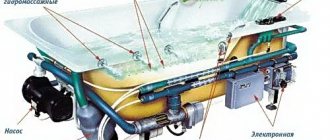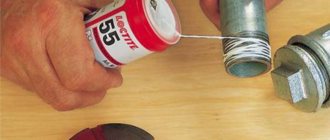Added by: Vladimir Doneshko March 16
With the advent of pipelines, humanity was faced with the issue of sealing connections. This problem is solved using various sealing materials. One of the most common at the moment is the FUM tape. To ensure reliable fixation with its help, it is important to know how to wind this seal.
- 2 How to wind the seal correctly and how much
2.1 Video: How to screw FUM tape onto a thread
Where is it used?
Due to its properties and characteristics, FUM tape is used in most situations where sealing treatment is required.
- Water pipes . The most important thing that FUM tape is used for is sealing water connections. The material is water-repellent, which makes it almost indispensable for fastening water pipes and parts during the assembly and installation of equipment.
- Gas pipeline . The film can be made gas-tight, and it can be used to install gas appliances and meters. However, not every FUM tape is suitable for this purpose; you need to purchase a specialized tape for gas.
- Technique . The material is characterized by resistance to various types of influences, therefore it is actively used to repair internal mechanisms of cars and various technical devices.
Heating pipes fastened with tape Source re-st.ru
Welding of gas pipelines
Welding of gas pipes under pressure is carried out by highly qualified welders who have certificates for such work.
Manual arc welding and flash contact welding do not provide reliable corrosion resistance of the joint area
, only the pressure welding method eliminates these disadvantages.
Welding in a special welding installation occurs in this way: - the pipe is fed along the roller channels until it stops at the stopper of the immovable clamp and the pipe is clamped there. The supply of the second pipe is carried out until it stops at the first pipe, then the movable clamp is clamped; — a special mechanism regulates the difference between the edges and pre-pressure is created at the joint through a movable mechanism; — by longitudinal and transverse movement of the heating unit supports, the inductor is first adjusted to the junction and then closed; - turn on the induction heating source, and when the welding temperature is reached, the temporary relay will turn off the heating source; — the time allocated for welding one joint is no more than one minute; — a command is given for the upsetting of the welded pipes; after upsetting, the clamping devices are unclenched, the movable clamp returns to its initial position and the installation is ready to accept a new pipe.
This welding method is used in the gas industry to join ferrous pipes and pipes with an internal anti-corrosion coating.
Pros and cons of using
The main advantage of choosing tape is its availability. FUM is sold at a low price, cheaper than flax tow and most other sealants used in plumbing.
The material is characterized by ease of installation. With proper skill, winding the tape occurs in a matter of seconds, but for this you should practice winding it on connections of different diameters for some time.
An important advantage of using tape is that the parts fastened with it can be easily disassembled. The connections do not freeze tightly; they can be disassembled even years after installation.
The main disadvantage of the material is that it is not the most reliable of seals, therefore, as a rule, it is not used for industrial installation. However, for household repairs the hermetic properties of FUM are quite sufficient.
Another disadvantage is that the tape often protrudes outward from the joints, so the pipes may look sloppy because of this.
Tape on thread Source sdelairukami.ru
Sealing of household air ducts
Ventilation in apartments and country houses is carried out using thin-walled elements. Often, air ducts are made of rectangular cross-section or from corrugated pipe. Threading on such connections is not possible. Therefore, sealing ventilation joints is carried out in other ways:
- through flanges,
- applying a bandage,
- using the socket method by inserting one air duct into another.
A flange connection is most often used for non-circular ducts. Sealing is carried out using gaskets made of soft material, for example, porous rubber. The shape of the gasket must match the cross-section of the air duct.
With other methods, the voids formed after joining the air ducts are filled with mastics whose temperature characteristics correspond to the operating conditions of the air line. Sometimes the joint of the air ducts is wrapped with self-adhesive tape.
Bandage clamps used for joining round air ducts
Specifications
Let's consider the technical characteristics of the FUM tape, which determine its properties:
- the material is characterized by resistance to damage;
- has plasticity;
- retains its properties for a long time and does not need regular replacement;
- is environmentally friendly and does not emit harmful substances;
- heat-resistant, able to withstand a wide range of temperatures;
- the thickness is only two tenths of a millimeter;
- has dielectric properties and gas impermeability;
- elastic, capable of stretching almost twice its original length.
—
CONDITION 1
| RESULTS. â |
RESULTS RESULTS RESULTS. RESULTS ÑÐ±Ñ Ð¸ нанеÑÐµÐ½Ð¸Ñ Ð±Ð¸ÑÑмнÑÑ Ñлоев ÑовмеÑÐµÐ½Ñ Ð¸ Ð ²ÑполнÑÑÑÑÑ Ð½Ð° одной ÑÑÑÑÐ °Ð½Ð¾Ð²ÐºÐµ, ÑазмеÑаемой в конÑе поÑоÑной лиР½Ð¸Ð¸. â
| RESULTS. â |
RESULTS RESULTS ASSURANCE RESULTS. â
| RESPONSIBILITY, RESULTS °ÑÑка газо. â |
RESULTS, RESULTS ÑопиÑанной клеем. RESULTS RESULTS ¿Ð»Ð°ÑÑиковÑÑ Ð¾Ð± олоÑкÑ-бандаж. ROOM давлениÑ. â
RESULTS ¸Ð·Ð¾Ð»ÑÑионнÑм маÑеÑиалом. RESULTS. â
| RESULTS. â |
RESULTS s ROOM CONTENTS, CONDITIONS линии. â
| RESULTS. â |
ROOM CONTENTS , , , , , , , , ¾Ð»Ð¾Ñки; RESULTS OPTIONS . ROOM ROOM . â
RESPONSIBILITY ss, ss RESULTS CONCLUSION: 1) ROLLING UP, LOCKING ´Ð½Ð°Ð· наÑеннÑÑ Ðº гÑммиÑованиÑ; 2) RESEARCH, CONDITION; 3) RESULTS ROOM из ÑаолиÑа; 4) RESULTS з ÑекÑÑоѰолиÑа и дÑ. RESULTS, RESEARCHES ÑÑ ÑÑанение вÑÐµÑ ÑÑÐ¸Ñ Ð²ÐµÑеÑÑв. â
RESULTS RESULTS RESULTS. RESULTS ÑÐ±Ñ Ð¸ нанеÑÐµÐ½Ð¸Ñ Ð±Ð¸ÑÑмнÑÑ Ñлоев ÑовмеÑÐµÐ½Ñ Ð¸ Ð ²ÑполнÑÑÑÑÑ Ð½Ð° одной ÑÑÑÑÐ °Ð½Ð¾Ð²ÐºÐµ, ÑазмеÑаемой в конÑе поÑоÑной лиР½Ð¸Ð¸. â
| RESULTS. â |
→ RESULTS RESULTS RESEARCH Ñой, п ÑопиÑанной ÑпокÑиднÑм клеем. RESULTS RUR 50 RUR °Ñи и вÑÑе. RESULTS оÑиÑаÑÑ. â
Using FUM for water connections
The use of sealed film for water connections has certain advantages compared, for example, with the use of flax tow and sealant
Taped water connections Source userapi.com
See also: Catalog of companies that specialize in water supply and sewerage work.
When using sealant, depending on its type, the connection can be sealed almost tightly, and if dismantling is necessary, the pipes will take a long time to disassemble.
The advantage of using FUM tape for water is that it does not interfere with the dismantling of pipes, is sufficiently waterproof and is easier to use. It can also be used together with flax as an additional sealant.
Disadvantages, negative points
Despite the large number of advantages, natural sealant is not without its disadvantages. They are especially obvious when installation and repair technology is violated. After short-term use, rust may form at the joints, making it difficult to dismantle structures during subsequent repairs. In view of this, it is recommended to regularly inspect connections for leaks and take measures to eliminate damage.
The material is very sensitive to the quality of work, so it is recommended to use it only by experienced craftsmen.
Attractive physical properties are compensated by the low chemical sensitivity of the material. Thus, flax fibers will be destroyed under the influence of antifreeze if they are part of the mixture passing through connected communications.
Using FUM for a gas pipeline
To fasten gas pipeline parts and install gas equipment, you should use only special FUM tape for gas. It must be supplied with a certificate of conformity confirming its suitability for use on gas pipes.
The special film for gas is yellow. It is made wider - up to two centimeters in width.
Yellow FUM tape for gas Source megastroy.com
The use of the material is possible only when sealing can only be achieved using a sealant. In the case of rubber hoses, as well as metal hoses, the sealing function is provided by a special gasket. In this case, the additional seal will not add tightness to the connection, and may even break it, as it will interfere with the tight fit of the gasket.
Fighting the leak
Fixing a heating system leak using a sealant is a chemical fight against leaks.
The specified German sealant proved to be excellent in solving this dilemma. The following tools are also used:
- Resins with two components based on epoxy.
- Adhesive silicone compounds.
- Heat-resistant compounds based on rubber.
Their algorithm:
- The damaged area is degreased, dried, and covered with a thin layer of sealant.
- Next, it is wrapped with serpyanka. Serpyanka reinforces the sealed layer.
- The serpyanka is already covered with sealant. The action is repeated.
If a silicone product is used, then you do not need to use abrasives to grind the damaged area. And this type of sealant adheres better to a smooth surface.
How to wind tape
In fact, to figure out how to properly wind FUM tape onto a thread, you do not need to have any special skills. However, certain operating features should be taken into account in order to protect connections from leaks.
Before winding FUM tape, you must first thoroughly clean the parts. All joints must be treated with a solvent and dried to prevent debris from getting under the tape.
Winding tape onto a thread Source sovet-ingenera.com
Requirements for gas sealants
To completely eliminate gas leakage at the connecting points of the gas pipeline system, it is necessary that the winding meet the following requirements:
- resistance to vibrations of varying intensity;
- resistance to sudden changes in temperature and internal pressure;
- protection of the connection from the formation of corrosive deposits;
- ease of installation and dismantling in case of repairs;
- durability and long period of use.
All sealing materials must be tested by specialists for strength and certified for use in gas supply systems.
Things to consider
When working with tape, it is necessary to take into account some of its characteristic features.
- The tape is quite slippery, so you need to wind it carefully so that the strips do not move out of bounds. It is advisable not to allow the edge to fall out into the inside of the connection.
How the tape should be positioned on the thread Source abro-ind.ru
- Once the film has already been wound, it cannot be unwound and re-wound - this will break the tightness. Try to process it carefully right away, otherwise you will end up wasting a lot of material.
- Also, the tightness will be broken if there is a need to loosen the connection. In this case, you will also have to rewind the material.
Non-hardening pastes
This type of sealant is a reliable and inexpensive way to prevent the possibility of leaks. The material itself is quite easy to install. Non-hardening pastes are a viscous substance based on oils, synthetic resins and fillers. It is worth noting that this material can only be used for low pressure pipes and gas pipelines.
Advantages of non-hardening pastes:
Easy to install, you just need to lubricate the thread surface.
- Easy to tighten.
- Easy dismantling of the system.
Now let's move on to the disadvantages of this material:
- At high pressure, the sealing material is gradually squeezed out of the threaded connection.
- Only seals well at low pressure connections.
- Cannot be used with small thread gaps.
- There is no strong fixation of the connection.
So, we can conclude that non-hardening pastes are a good method of sealing, they are reliable and will not break your wallet, but are only suitable for low pressure systems.
Other seal options
Of course, FUM tape is not the only existing option for sealing joints. Among others, linen tow should be highlighted, along with which various types of sealants, as well as plumbing thread, are used to fasten pipe parts. Let's consider their advantages and disadvantages in comparison with FUM.
Flax tow
Linen is also one of the most popular materials. Just like FUM, it is customary to wrap tow in a dense layer.
It is important to wind the tow carefully and tightly, filling the thread completely along the turns. The outside of the fibers is additionally coated with paint or sealant. This leads to the main disadvantage of this material. It should be borne in mind that if paint is used, the connections cannot be dismantled and the pipes will be unsuitable for repair.
Flax tow Source ytimg.com
Also, the disadvantage of this material is its relative fragility. Unlike tape, flax is subject to gradual decomposition under the influence of moisture.
The main advantages of tow in comparison with FUM are:
- Adjustability. After winding and securing the connection, it is possible to unscrew it at a slight angle without loss of tightness and the need to replace the sealing material.
- Reliable sealing, high degree of tightness and ability to absorb liquid.
- High resistance to various types of physical influences.
- Easy to disassemble the connection.
If you have to choose what is better to use – ribbon or linen tow, then there is no definite answer. As a rule, it is recommended to use tow for intermediate pipeline connections. The tape is more suitable for securing taps, meters and mixers.
Sealants
When using flax tow, for a better fit and seal, the joint is additionally treated with a liquid sealant.
Liquid sealants Source ad-cd.net
Rules for carrying out work
You can even wind flax onto threaded connections using your own technology, which may differ. For example, some craftsmen twist it in the form of a tourniquet, while others simply braid it into an ordinary braid or apply it using the loose thread method.
Additional lubricant can be applied in a variety of ways. For example, apply it to a clean thread, and only then wrap it with tow. Afterwards it is necessary to open it with another additional layer. Another way is to thoroughly soak the fibers and only then carry out the preparation.
If the necessary knowledge is missing and you want to find out how to properly wind flax on a thread - clockwise or in the opposite direction, then the opinions of experts on this issue vary, since some of them adhere to the first method, while others adhere to the opposite. It is most optimal to wind the material taking into account the turns of the threaded connection. If there is a left-hand thread, the flax fibers should be wound clockwise; if it is right-handed, then in the opposite direction.
Regardless of this, it is imperative to press the edge of the strand beyond the boundaries of the turns with your finger and when making the first turn it must be in the form of a cross, thanks to which it is possible to secure the material. When performing this process, it is necessary to exclude the presence of any gaps. To avoid this, the turns should lie tightly to each other. Closer to the edge of the pipe, the thickness of the flax being wound should be reduced, so that the nut will fit more easily onto the threaded part.
Upon completion of winding, it is necessary to separate the excess tow, glue its edge with sealant, and then the winding must be aligned flush with the thread. It is best when the maximum force applied to the nut falls on the outermost 2-3 turns of the threaded connection, and during final tightening, some of them remain on the outside. If the nut is screwed on by hand and it moves easily during the process, then a very small amount of material has been wound. In this case, it is necessary to wrap more tow on top of it or remove it and repeat the process from the very beginning.
Note! When tightening the nut, do not allow the flax to be knocked to the edge.
Upon completion of installation, the tow peeking out from under the nuts must be trimmed or smoothed at the junction. In addition, after this work, the connections consisting of ferrous metals should be painted, so that they can be protected from corrosion.
Briefly about the main thing
FUM tape is one of the popular and effective sealing options. It is affordable, easy to use, and does not create problems during subsequent repairs.
There are several simple rules on how to wind FUM tape onto a thread:
- the winding area must be cleaned;
- the tape is wound along the thread - how the nut will move along it;
- When winding the tape, you need to tighten it a little;
- Usually four layers are enough, but sometimes more are required;
- After winding the tape, the thread relief should be palpable.
Ratings 0
Read later











